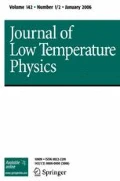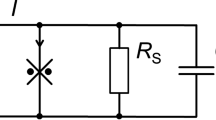Abstract
We investigate rf SQUIDs (Superconducting QUantum Interference Devices), coupled to a resonant input circuit, a readout tank circuit and a preamplifier, by numerically solving the corresponding Langevin equations. The quantity of interest is the noise temperature T N . We use an analytical expression T N0,opt, which is already optimized for the parameters of the input circuit, and vary the model parameters of the remaining circuit to minimize T N0,opt. We also compare T N0,opt to numerical simulations of the full circuit and find good agreement. The best device performance is obtained when β′ L ≡2π LI 0/Φ 0 is in the range 0.5–0.9; L is the SQUID inductance, I 0 the junction critical current and Φ 0 the flux quantum. For a tuned input circuit we find an optimal noise temperature T N0,opt≈3Tf/f c , where T, f and f c denote temperature, signal frequency and junction characteristic frequency, respectively. This value is close to the optimal noise temperatures obtained by approximate analytical theories carried out previously in the limit β′ L ≲1. We study the dependence of T N0,opt on various model parameters away from their optimum values, and often find much lower values of T N0,opt than predicted by the analytical theory. We finally discuss implications for devices that can be implemented experimentally.
Similar content being viewed by others
References
B. Chesca, R. Kleiner, D. Koelle, in The SQUID Handbook, vol. 1, ed. by J. Clarke, A.I. Braginski (Wiley-VCH, Weinheim, 2004), p. 29
R. Kleiner, D. Koelle, J. Clarke, A numerical treatment of the rf SQUID: I. General properties and noise energy. J. Low Temp. Phys., this issue. doi: 10.1007/s10909-007-9511-x
V.V. Danilov, K.K. Likharev, O.V. Snigirev, in Proceedings of SQUID ’80 (de Gruyter, Berlin, 1980), p. 473
G.J. Ehnholm, J. Low Temp. Phys. 29, 1 (1977)
J.N. Hollenhorst, R.P. Giffard, J. Appl. Phys. 51, 1719 (1980)
J. Clarke, C.D. Tesche, R.P. Giffard, J. Low Temp. Phys. 37, 405 (1979)
M.W. Pospieszalski, IEEE Microw. Mag. 62 (2005)
R.F. Bradley, Nucl. Phys. B (Proc. Suppl.) 72, 137 (1999)
F.N.H. Robinson, Noise and Fluctuations in Electronic Devices and Circuits (Oxford University Press, London, 1974)
M. Mück, Y. Zhang, Private communications
K. van Bibber, L.J. Rosenberg, Phys. Today 59, 30 (2006)
M. Mück, M.-O. André, J. Clarke, J. Gail, C. Heiden, Appl. Phys. Lett. 72, 2885 (1998)
Author information
Authors and Affiliations
Corresponding author
Rights and permissions
About this article
Cite this article
Kleiner, R., Koelle, D. & Clarke, J. A Numerical Treatment of the rf SQUID: II. Noise Temperature. J Low Temp Phys 149, 261–293 (2007). https://doi.org/10.1007/s10909-007-9512-9
Received:
Revised:
Published:
Issue Date:
DOI: https://doi.org/10.1007/s10909-007-9512-9




